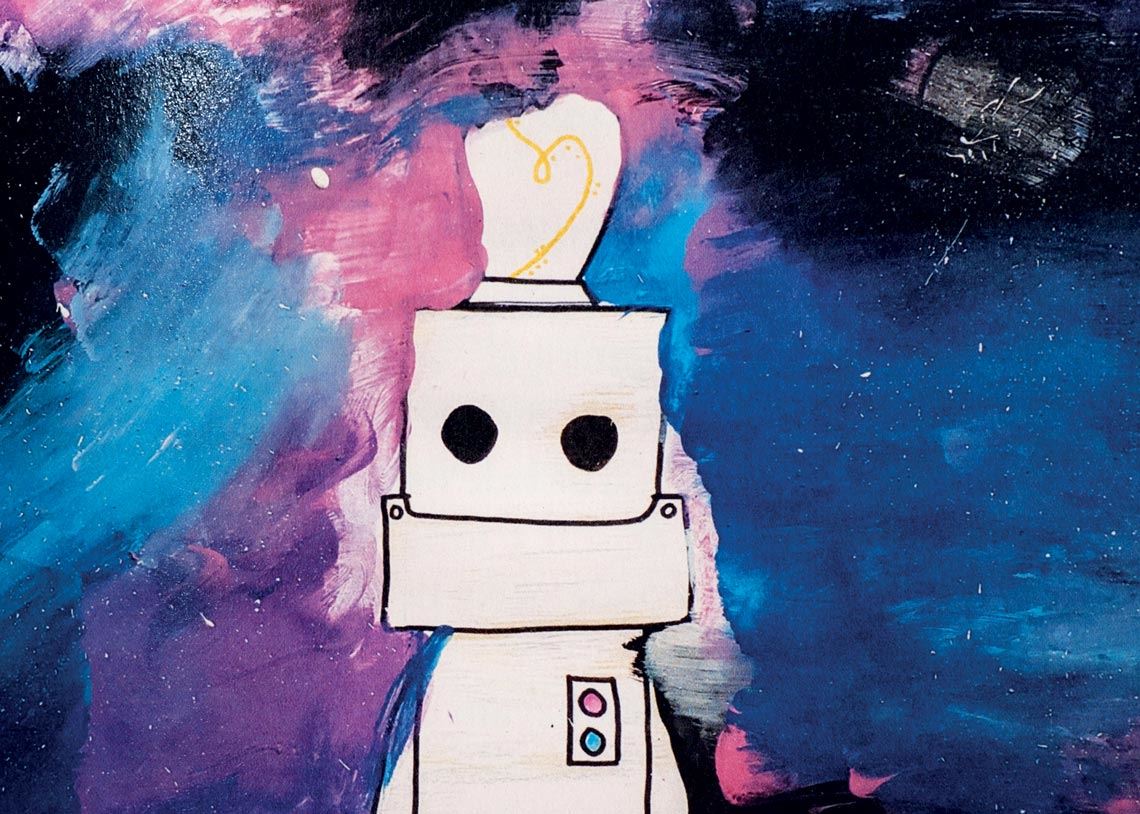While teaching at a technical high school in Campinas between 2009 and 2015, chemist Haira Gandolfi would say to her dedicated students in their course conclusion projects: “if you don’t really understand a concept or technique that you intend to use in your projects, look for a published scientific text that addresses the topic; this is an ideal point of entry to more complex academic texts.” Gandolfi moved to the United Kingdom (UK) and was contracted in September 2020 by the Faculty of Education at the University of Cambridge in the UK. In addition to teaching classes and undertaking research, he lectures teachers in Brazil who teach in elementary, secondary, and technical schools. “This type of material here has tremendous value and is used widely, including in entrance exams for post-secondary institutions and other disciplines beyond science.”
Written by journalists, the reports of Pesquisa FAPESP, which has reached its 300th edition this month, seek to stimulate students and support teachers of science and other disciplines to present topics to be explored in-depth in textbooks. Other publications that address science and technology, such as Superinteressante (Superinteresting), Galileu (Galileo), Ciência Hoje (Science today), and Química Nova na Escola (New chemistry in school), can also have significant use in the classroom.
Since 2012, in an effort to promote interest in scientific topics and promote scientific production in Brazil, Pesquisa FAPESP has distributed each month 3,600 complimentary issues of its print magazine to the libraries of public high schools in the state of São Paulo. Teachers can also access their open site (www.revistapesquisa.fapesp.br) for reports, videos, and podcasts.

Pedro Souza de Freitas / Queen of Peace School
Other drawings for the science fiction book inspired by the reports of Pesquisa FAPESPPedro Souza de Freitas / Queen of Peace School“Using Pesquisa FAPESP, I was able to show my students the paths for confirming or rejecting the hypotheses of a scientific study,” comments geographer and geography professor Pedro Henrique Ferreira Costa. In the second quarter of 2019, he explored 27 reports of the journal about the formation of the universe with his four 6th grade classes from Rainha de Paz (Queen of peace), a private school in the São Paulo State capital. The activity was part of the sixth version of the quarterly project about science fiction, coordinated by Portuguese language teachers.
Costa distributed the texts to his students, without a collective reading script, and asked then to reach them by the following class. In their next class, many complained they could not understand anything. The teacher proposed doing a collective reading of the articles to discuss the most important parts, distributed the reading script, formed pairs of students to read the same texts, and monitored a debate among them. In the next stage, the students researched on the internet about topics of the reports they worked with.
In another class, the students presented and debated the texts they had received. In the final stage, also with the help of teachers, they wrote their own science fiction stories. The stories were then reviewed by their classmates, with the help of Portuguese language teachers Mara Dias and Vanessa Caires. The stories were then assembled into a book that was published in December 2019.
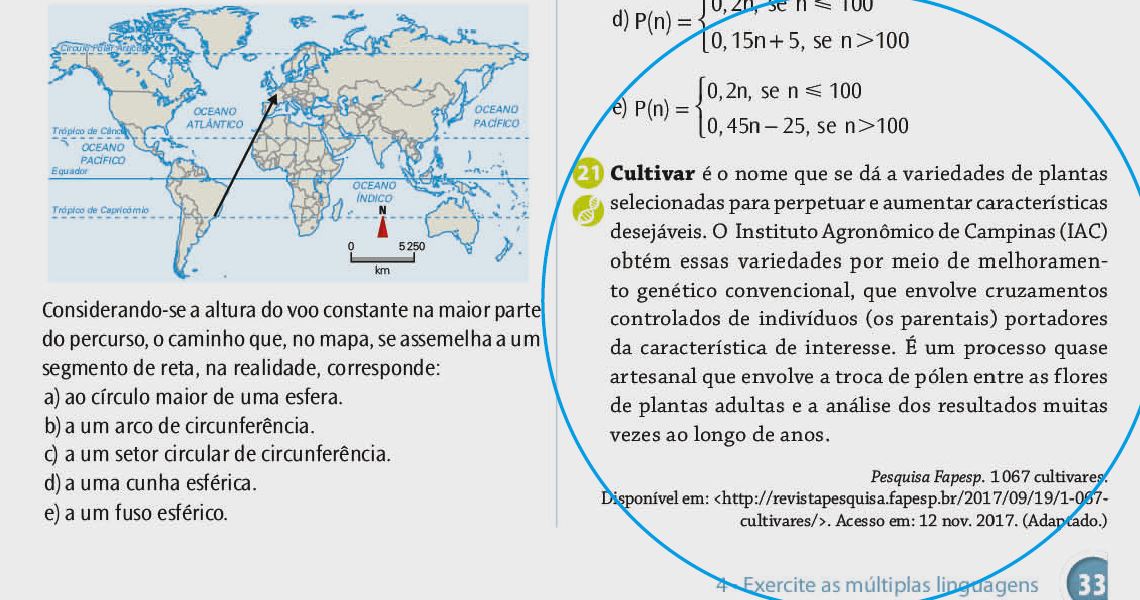
Grupo Somos
The journal inspired one of the questions in the 2018 ENEMGrupo SomosSimilarly, at the beginning of 2020, biologist Fábio Falla left several copies of Pesquisa FAPESP in his classrom at the state school Prof. Genézia Izabel Cardoso Mencacci, located in Sorocaba in the interior part of São Paulo State. When class began, he asked his 6th grade science classes to check out the journal during their break times—school is full-time from 7:15 a.m. to 4:00 p.m.—and write a report about something that interests them. The teacher helped with the group activity, identifying key ideas, the relevance of the topic, the researcher, and the location of the projects presented in the reports. “If they did not understand a concept, they would look on their own in other sources,” says Falla. The students wrote five summaries with an average of 10 lines each, which contributed to their semester grade.
Satisfied with the result, albeit frustrated with having to stop the project in March when schools closed due to the pandemic, Falla concluded that there is still much to do: “In general, the students still view scientists as isolated from the world. We need to present their projects as more connected to the real world, so that the science narrative makes more sense.”
We need to present the work of scientists as more connected to the real world, so that science makes more sense, notes Falla
In 2018 and 2019, geographer and geography professor Mariana Doneux studied, along with her 8th grade class from a private school in São Paulo, a report about the quilombola communities of Vale do Ribeira (see Pesquisa FAPESP issue no. 232). “The report presents different researchers’ views about their way of life, farming practices, and the history of struggle of those quilombola communities,” she says. Doneux and her students visited one of the region’s quilombos, Ivaporunduva, and later used the report to confirm their conclusions.
With a bachelor’s degree in chemistry, Jemusu Takano used a different approach. In 2020, as had been done in 2019, in the name of the Rosa Maria Castanho Educational Center, a private institution in the city of São Paulo and also known as Cermac School, Takano—who is the school’s pedagogical coordinator—obtained 95 subscriptions for Pesquisa FAPESP and included the journal on the list of school supplies for high school students.
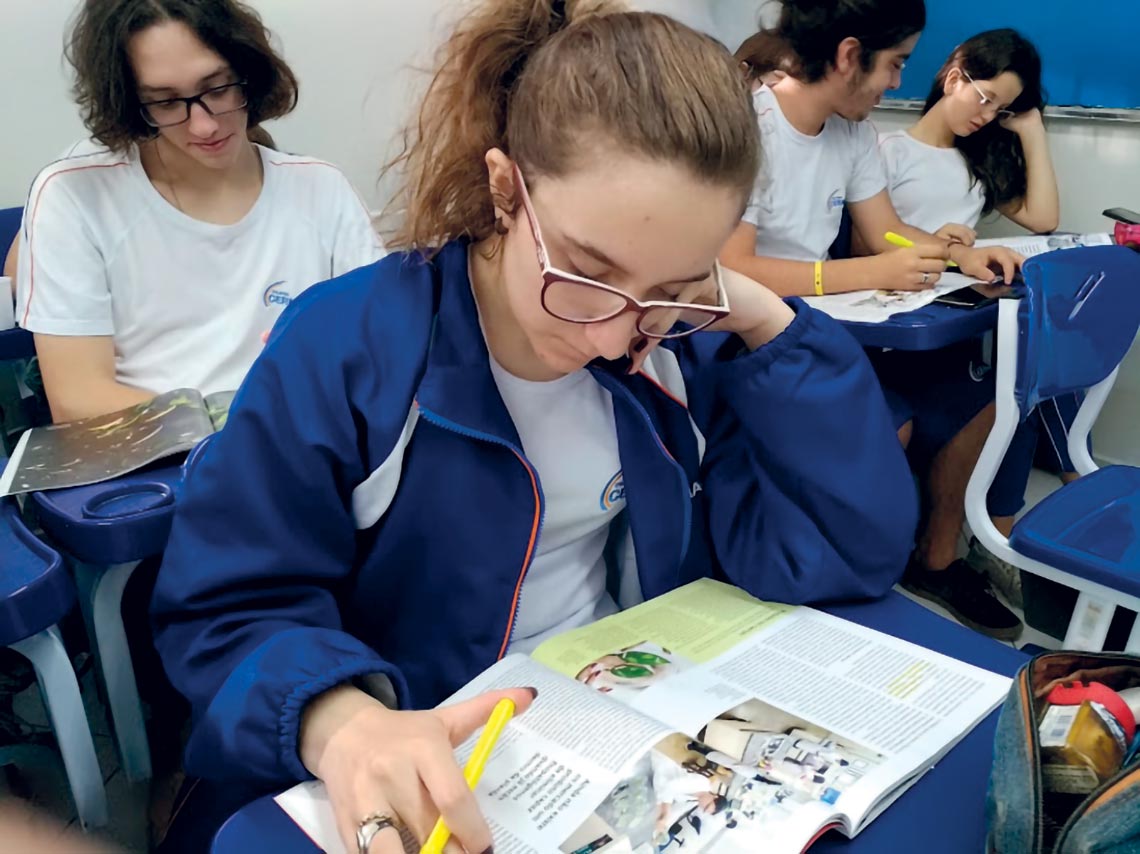
Cermac School Archive
Students from Cermac School, in the capital, exploring Pesquisa FAPESPCermac School ArchiveIn 2020, until the arrival of the pandemic, in weekly social studies classes, students were organized in groups, chose a report, and prepared a presentation for their classmates, in monthly cycles: in the first class, they formed groups and chose a topic; in the second, they outlined their presentations; and the third and fourth classes were reserved for presentations and debates.
Projects with the journal are integrated with other activities, such as field trips and environmental projects, such as recycling waste. “We want to place the students in contact with the world of science and show them there is national output in this area,” emphasizes Takano.
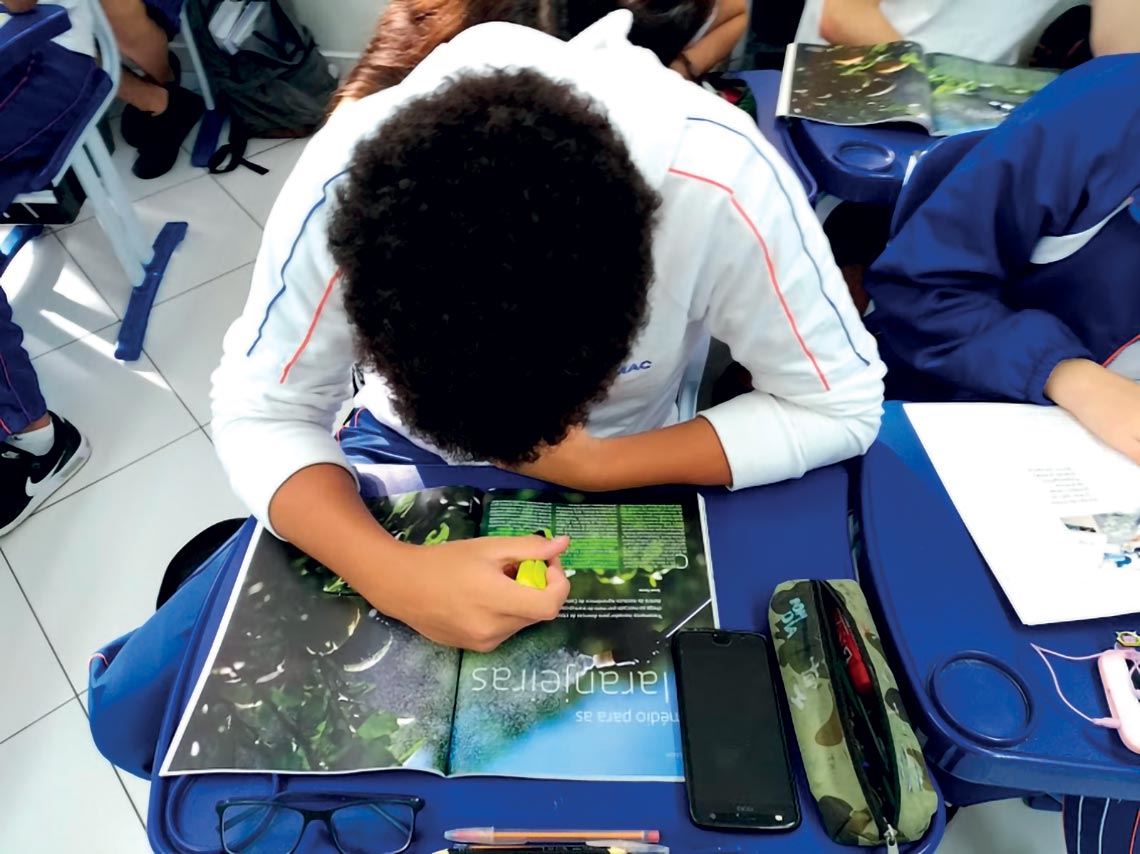
Cermac School Archive
Students from Cermac School, in the capital, exploring Pesquisa FAPESPCermac School Archive“I discovered I can use online materials, which facilitates a lot,” says biomedical scientist Naiara Dejani. In 2019, she used one of the journal’s reports on blood types (see Pesquisa FAPESP nos. 113 and 122) in her 12th grade genetics class that is integrated with the biotechnology technical school of the Federal Institute of Espírito Santo (IFES) in Vila Velha. One of its aims is to debate the effects of consanguine marriages.
With a doctorate and post-doctorate from the School of Public Health at the University of São Paulo (FSP-USP), Dejani was contracted in December 2019 by the Federal University of Paraíba (UFPB) and continues to use Pesquisa FAPESP reports to keep her students current, primarily about the pandemic. “We have debated antivaccine movements, the decline in vaccine adherence, and what could be improved in public management to facilitate access to vaccines,” she reports. “The students have been very participative.”

Prof. Genézia Mencacci State School Archive
Students from Genézia Mencacci School, in Sorocaba, exploring Pesquisa FAPESPProf. Genézia Mencacci State School ArchiveTeacher training
“When using journalistic science texts, teachers must take care to not pass along wrong information and to adjust the language to the students’ level of understanding,” suggests Raiane Tavares Fortuna, professor with the State Secretariat of Education for the Federal District. In 2017, upon concluding a diploma course in natural sciences at the University of Brasília (UnB), she interviewed 39 students between their 5th and 8th semesters of the program to become teachers. She concluded that 87% answered that they considered these publications as educational material; 64% were used to reading journals of this type; and 51% had confused scientific publication, directed to a general public, with scientific communication, expressed in scientific journals read by specialists of the same area as the authors of the articles, as detailed in an article of September 2020 in the journal Ciência em Foco (Science in focus).
Chemist Nara Nobre-Silva, high school teacher and professor with the Goiás Federal Institute of Education, Science, and Technology, underscores two requirements to be able to use published scientific texts as educational material: the didactic and the link with daily life, which both help engage students. In an article published in August 2020 in Tear: Revista de Educação, Ciência e Tecnologia (Tear: Journal of education, science, and technology), she and chemist Roberto Silva of UnB examinated academic journals that describe ways of using published scientific texts in the classroom. Of the nine identified journals, two stood out, Alexandria, of the Federal University of São Carlos (UFSC), e Ciência e Educação (Science and Education), of the São Paulo State University (UNESP), respectively with 13 and 19 articles on this topic between 2008 and 2018.
“Published scientific texts are still used very little in elementary schools and high schools,” concludes Silva. To change this situation, he has offered a course since 2017 to promote science in post-graduate science teaching programs at UnB, for elementary and high school teachers.
Journalistic texts help to show that science is a collective endeavor and is subject to uncertainty, says Figueirôa
Geologist Silvia Figueirôa, of the Faculty of Education at the University of Campinas (FE-UNICAMP), with 30 years’ experience in history and teaching science, adds: “Teachers can use published scientific texts not only for their content, but also to show that science is a collective effort, is subject to uncertainty and dispute, and has limits and adopts methods that vary according to the area and time period.”
In courses for teachers in the UK that are interested in using this type of material in the classroom, Gandolfi suggests: “It is important to set aside a celebratory view of science, since no one makes a scientific discovery out of nothing, and clarify for the students the economic, political, and social structures that support the production of scientific knowledge.” In her opinion, this view of science could explain, for example, why measures to contain the pandemic vary between countries. Gandolfi explained her position in an article published in June 2017 in School Science Review.
Publication is also used to support undergraduate courses
Pesquisa FAPESP reports have also been used for many years for the National High School Exam (ENEM) and for entrance exams for public universities in the state of São Paulo. The entrance exam for the class of 2021 for the University of Campinas (UNICAMP), for example, included two questions based on the journal’s reports, one about Brazilian biomes and the other about hunting wild animals. FUVEST, which selects students for the University of São Paulo (USP), included a chemistry question in the first phase of the entrance exam in 2019, based on a record of a molecule being created in laboratory.
The use of the journal in higher education courses as a teaching support is also not uncommon, due to the fact that the reports cover topics of scientific knowledge in all subject areas. At least once per month, since 1998, when he began to lecture at the Federal University of Pernambuco (UFPE), agronomist Marcelo Tabarelli would read a Pesquisa FAPESP report to his biology students, to give context to what he was teaching about ecology or botanical economics. He recommended they read the journal and left copies in his Plant Ecology Laboratory. “Some reports, such as that which covers the journey of chemist Otto Gottlieb [see Pesquisa FAPESP issue no. 296], and the profiles of professionals in the Careers section, show the possibilities for working in the field of biology,” he adds.
When the pandemic began, Tabarelli increased his use of the journal in his remote classes of Evolution 2, in which he discusses changes in the use of soil, such as deforestation, farming, and forest fragmentation. To complement the two hours of weekly theory classes, he asked 33 students to choose five of the journal’s reports, among the 15 he had already pre-selected, and to prepare a summary, highlighting the problems presented and use them to propose a theoretical or practical research project, based on a script he had previously distributed. “The reports served to present the environmental problems, providing context and examples for the concepts,” he says.
Ethics in Science
“I always read Pesquisa FAPESP to see what I can use in my classes,” says biologist Marcos César de Oliveira Santos, from the Oceanographic Institute at USP. He takes from the reports information not only about animals—primarily marine mammals, his specialty—but also about ethics in science.
This is what he did in 2020, when he debated with his students the condemnation of a French doctor, who concealed his connection with companies that raised suspicions about the veracity of his research results on the effects of pollutants on human health (see Pesquisa FAPESP issue no. 259). As part of the assessment, his students had to present a scientific topic to hypothetical readers with little knowledge of the area, in the style of scientific journals.
Publishers use the journal’s texts, photos, anad infographics
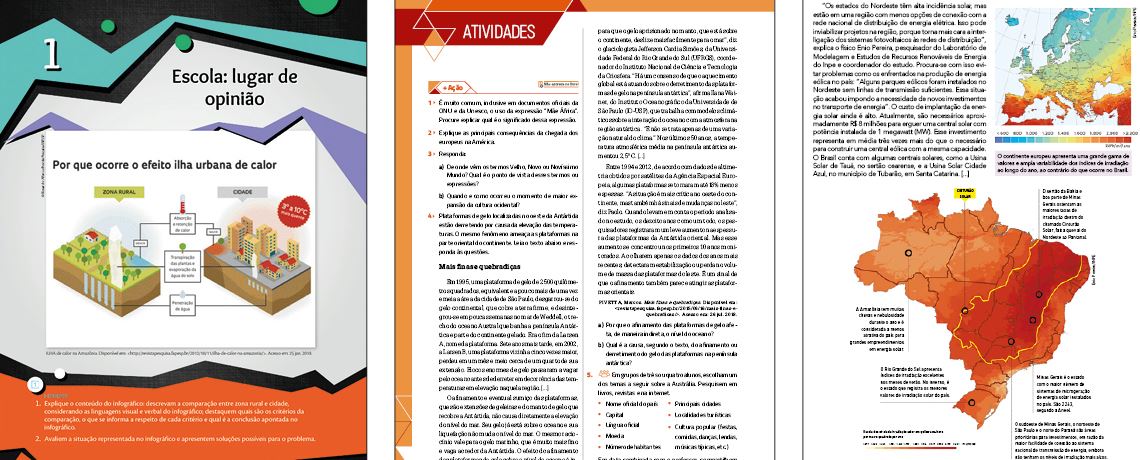
Reproduction
Journal infographic in a book by Positivo Publishing (left) and excerpts of reports in materials from the We are Group and Brazil PublishingReproductionAn indication of the teaching value of the journal Pesquisa FAPESP is the growing use of its reports in educational textbooks. The number of texts, photos, and infographics licensed for use by publishers increased from 31 in 2010 to 99 in 2020.
Maiara Oliveira Soares, natural sciences editor from elementary to high school education with the publisher Moderna, uses excerpts of the journal’s reports to enhance educational textbooks with current events for teachers. “We want teachers to have more information about topics they teach and to be familiar with journalistic science texts,” she says.
At SM Education, which also produces educational textbooks, editor Isis Ridão Teixeira used, in a teacher’s guide, excerpts of an interview with sociologist Reginaldo Prandi (see Pesquisa FAPESP issue no. 72) at the University of São Paulo (USP) to “reinforce the dialogue about the philosophy and way of life of the Iorubá, the effects of the African diaspora, and their historical survival in Brazil today, particularly in relation to the candomblé,” she reports. The student version of this collection included a map with the location of the territories occupied by the Iorubá today, a photo depicting a celebration to honor Oxum in Nigeria, and two watercolors of the Orixá created by Brazilian artist Jonas Tavares.
In her opinion, the choice of complementary material for educational books requires thought. “We look for texts in trustworthy scientific journalism vehicles and we check the credentials of the authors and research sources,” she says. “Another criterion is language, which must be accessible while guaranteeing an in-depth approach on the topic, presenting the characteristics of the scientific research it promotes.”
Jaqueline Paiva Cesar, coordinator of Editorial Projects at Poliedro, says, “Pesquisa FAPESP helps show students that Brazil produces quality science. The way the information is presented gives educators an important teaching resource to provide context to concepts and keep knowledge current.”
Scientific articles
FORTUNA, R. T. et al. A percepção dos licenciandos de ciências naturais sobre o uso pedagógico de revistas de divulgação científica. Ciências em Foco. Vol. 13, e020011, 1–15. Sept. 12, 2020.
NOBRE-SILVA, N. A. and SILVA, R. R. A circulação de ideias realizada por meio das atividades de divulgação científica em sala de aula: Um estudo das publicações em periódicos brasileiros. Tear: Revista de Educação, Ciência e Tecnologia. Vol. 9, no. 2, pp. 1–20. Aug. 12, 2020.
GANDOLFI, H. E. Teaching about nature of science in secondary education: A view from multicultural classrooms. School Science Review. Vol. 98, no. 365, pp. 77–84. June 2017.


